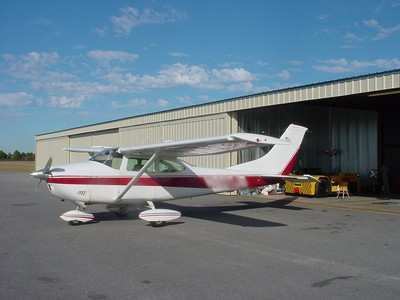Three Fatally Injured When Cessna 182 Impacted Terrain
The NTSB has released a preliminary report from an accident involving a Cessna 182 which fatally injured the commercial pilot and two passengers on board the aircraft.

The flight originated February 6 at 1307 from the Jackson-Hawkins Field Airport (KHKS), Jackson Mississippi, and was enroute to its intended destination of Shreveport Regional Airport (KSHV), Shreveport, Louisiana. Marginal visual meteorological conditions prevailed in the area and an instrument flight rules (IFR) flight plan was filed for the personal flight.
According to the report, preliminary radar data showed the airplane was enroute to its planned destination (SHV), about 6,000 ft when the pilot reported to Monroe Air Traffic Control (ATC) that he was encountering rime ice and requested a lower altitude. About 1350, ATC cleared the airplane to descend to 4,000 ft. The pilot queried ATC on the chances of being cleared to 2,000 feet and was advised 3,000 ft was the lowest he could be cleared to.
About 1355 the pilot requested and was cleared to 3,000 ft. The pilot then asked ATC to divert into Ruston Regional Airport (RSN) to remove ice off of the airplane. ATC vectored the airplane to the RNAV GPS 36 approach to RSN with a clearance to 2,000 ft until established on the approach. Radar contact was lost prior to the airplane reaching the initial approach fix (IAF) for the approach. Preliminary ADS-B data showed the airplane's ground speed slowing and a rapid descent before the radar contact was lost. Other than the report of ice, no distress calls were received from the pilot.
The airplane impacted a parking area surrounded by commercial buildings. Several workers in the building heard the impact. A first responder reached the accident site minutes after the impact, and shortly after his arrival, a post-impact fire ensued.
Examination of the airplane showed that it impacted the ground in a near vertical nose down attitude on a southerly heading next to a commercial building. The engine separated from the fuselage and was laying next to the initial impact crater. Both left and right wing leading edge impressions were present in the soft dirt on either side of the impact crater. According to a first responder, the airplane initially came to rest with the left wing against the building and the airplane sitting tail high. Subsequently, a post-impact fire occurred which consumed a majority of the fuselage and the left wing.
Both wing leading edges were crushed aft to the forward spar. All of the flight control surfaces remained attached to the aircraft, and no anomalies other than impact and fire damage were observed on the flight control cables to the ailerons and rudder. All flight instruments were consumed by the post-impact fire and Garmin G1000 data cards were not found. The engine was examined for drive continuity and compression and no pre-impact anomalies were discovered. All engine accessories that could be examined did not reveal any pre-impact anomalies.
A preliminary weather study of the area revealed that several other aircraft that were operating in the area reported ice at various altitudes near the accident location. The nearest weather reporting facility (RSN), located about 14 miles northeast of the accident site, reported the cloud ceiling in the area at 1,100 ft overcast. The temperature was 2 degrees C, and dew point -1 degrees C.
(Source: NTSB. Image from file. Not accident airplane)
 Unfortunate... ANN/SportPlane Resource Guide Adds To Cautionary Advisories
Unfortunate... ANN/SportPlane Resource Guide Adds To Cautionary Advisories ANN FAQ: Turn On Post Notifications
ANN FAQ: Turn On Post Notifications ANN's Daily Aero-Term (04.29.24): Visual Approach Slope Indicator (VASI)
ANN's Daily Aero-Term (04.29.24): Visual Approach Slope Indicator (VASI) ANN's Daily Aero-Term (04.28.24): Airport Marking Aids
ANN's Daily Aero-Term (04.28.24): Airport Marking Aids ANN's Daily Aero-Linx (04.28.24)
ANN's Daily Aero-Linx (04.28.24)



